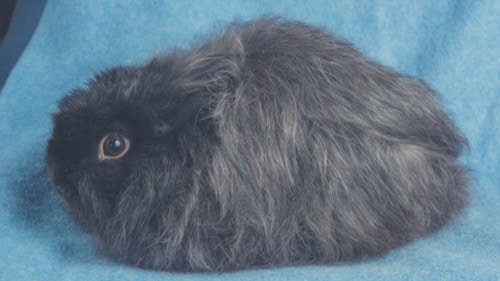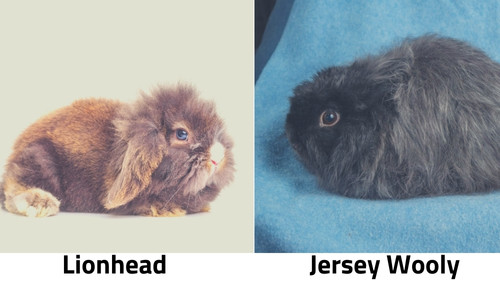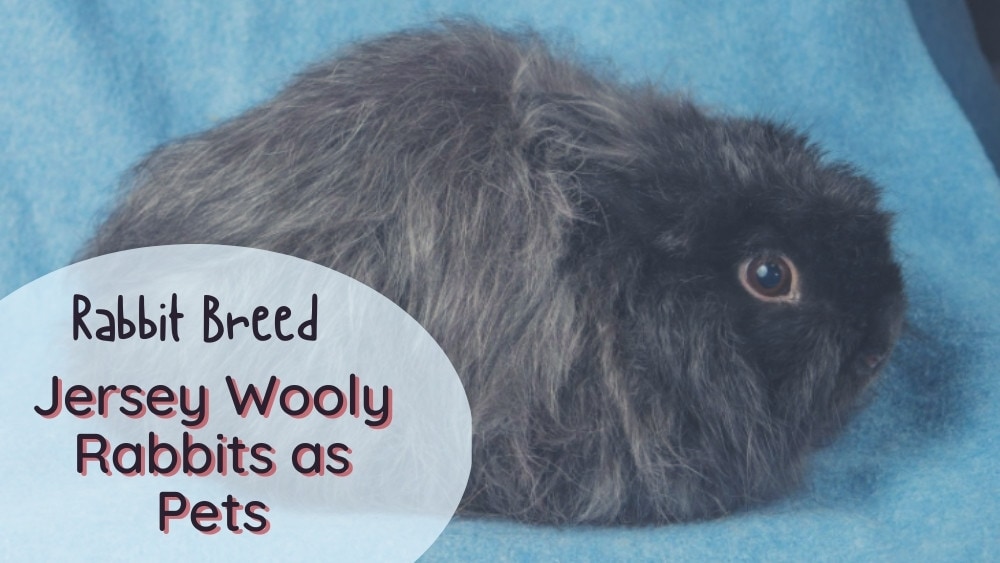The Jersey Wooly breed always reminds me of that page in a Dr. Seuss classic where a child is happily brushing the glowing, luxurious hair of a tiny pet. Because, as the book says, Brush! Comb! All girls who like to brush and comb should have a pet like this at home.
Many pet owners – and not just girls – are captivated by the charm of soft fluffy wool on an adorable bunny rabbit. But many aren’t able to invest the time it takes to care for a full-size Angora. So the Jersey Wooly fills this niche perfectly. It’s tiny. Adorable. Easy to care for. And it’s friendly.
Is this little Fuzzbutt the right choice for your family? I kept Jersey Wooly rabbits for 8 years. In this article, I’ll answer all your questions about keeping Jersey Wooly rabbits as pets.
What is a Jersey Wooly?
The Jersey Wooly is a dwarf rabbit breed with upright ears and easy-care wool that’s about 3 inches long. Jersey Woolies are known for their laid-back, affectionate personalities. This makes them wonderful pets for adults and children alike. Besides regular grooming, they do not have many special needs.
Breed Characteristics at a Glance
| Body Type: | Compact |
| Size Category: | Dwarf |
| Adult Weight: | 3 pounds (1.3 kg) |
| Colors: | Wide range of colors including agouti, broken, self, shaded, and tan groups |
| Coat Type: | Wool |
| Country of Origin: | United States |
| Countries Where Found: | Worldwide |
| Conservation Status: | Not Threatened |
| Temperament: | Docile |
| Special Needs: | Regular grooming, appropriate bedding |
What Does a Jersey Wooly Rabbit Look Like?
Jersey Woolies have blocky “mug” heads, small thick ears, and luxurious yet low-maintenance wool. The hair on a Jersey Wooly’s head, ears, and feet is short and has a “normal” texture, but the hair on its body grows to a length of about 3 inches long. The wool does not continue to grow once it has reached its mature length.
Jersey Wooly wool includes a longer outer coat (made of “guard hairs”) and a shorter undercoat. Its texture should be somewhat coarse compared to the light, fluffy wool of an Angora breed rabbit.
How Much Do They Weigh?
A typical Jersey Wooly may be between 2.5 pounds and 3.5 pounds. Breeders who show their Jersey Woolies consider 3 pounds to be an ideal weight. Some animals may approach 4 pounds, especially if they do not inherit the dwarf gene.
What Colors can Jersey Woolies be?
Jersey Woolies come in a large range of colors. If you’d like to identify the color of your Jersey Wooly, look at the fur on its head and ears. The pigment molecules are denser in the short hairs on the head and ears than in the long wool, making it easier to determine the hair’s true color.
The wool of a Jersey Wooly will always look lighter in color than the fur on the head and ears.
The American Rabbit Breeders Association recognizes six color groups for Jersey Woolies: Agouti, AOV, Broken, Self, Shaded, and Tan pattern.
- Agouti. The agouti pattern group consists of Chestnut, Opal, Squirrel, and Chinchilla colors. People associate chestnut with the “wild bunny” color.
- All Other Varieties (AOV). This catch-all group contains Orange and Pointed Whites. Pointed Whites are white rabbits with red eyes and colored ears, noses, feet, and tails.
- Broken. Broken pattern rabbits are spotted. They can be any recognized color in combination with white.
- Self. The self group includes solid-colored rabbits, like black, blue (gray), and white. White Jersey Woolies can have blue or red eyes.
- Shaded. Shaded varieties have one color that fades into another. Some shaded colors include Tortoiseshell (often called “tort”), Sable Point (think Siamese cat color!), and Smoke Pearl
- Tan. Includes Otters and Silver Martens. They have a solid color on top and a lighter color on their tummies.

Breed History: Where are Jersey Woolies From?
Bonnie Seeley of New Jersey first introduced the Jersey Wooly rabbit in 1984 at the American Rabbit Breeders Association (ARBA) Convention.
To develop this breed, she bred Netherland Dwarf rabbits with French Angoras, selecting only the best temperaments from that cross.
Her goal was to create a dwarf rabbit with fewer grooming needs than an Angora and a wonderful pet personality.
Bonnie’s dreams were realized. In 1988, the Jersey Wooly became a recognized rabbit breed and today is a popular pet.
What is the Difference Between a Jersey Wooly and a Lionhead?
The Jersey Wooly and the Lionhead are both popular pet rabbit breeds with short fur in some places and longer wool in others. They both weigh about 3 pounds.
The difference is that the Jersey Wooly has short hair on the head and long hair over the whole body, but the Lionhead has long hair around the head (and sometimes the rump) and short hair on the rest of the body.

Conservation Status
Jersey Woolies are not on the American Livestock Breeds Conservancy List of rare rabbit breeds. Instead, they are among the more popular show rabbit breeds.
Jersey Woolies are only found in countries where rabbit clubs use the American Rabbit Breeders Association Standards. Jersey Woolies can be found in the United States, Canada, Malaysia and Japan. Sometimes they are known as “Dwarf Angoras.”
Do Jersey Wooly Rabbits Make Good Pets for Kids?
A Jersey Wooly can be a good pet for a child if an adult closely monitors the rabbit’s care. Like all rabbits, they need round-the-clock hay and water, and frequent grooming.
Jersey Woolies can develop matted coats and a variety of secondary health problems if not cared for properly.
Personality and Temperament
Nicknamed the “no kick” rabbits, Jersey Woolies are docile rabbits that have clownish personalities. Be aware that “no kick” does not mean that these rabbits will not kick or struggle if held improperly or if they feel threatened. Always supervise small children and other pets when they are around your Jersey Wooly rabbit.
Affection
Do pet Jersey Wooly rabbits show affection? Yes, they do, and there are several ways they can show just how much they love you.
- Grooming. Rabbits may lick or groom your skin and clothes to show their love. Sometimes this grooming may take the form of light nibbling.
- Binky. This is a “twisty leap” in which the rabbit jumps and flips its ears, also kicking out its feet. It indicates they are very happy and feel safe with you.
- Demanding Head Rubs. If your bunny hops up to you and juts its head forward to beg for head rubs, you should feel very loved indeed.
- Circling Your Feet. If your Jersey Wooly likes to run circles around your feet, this means they are happy to see you! Some rabbits grunt while doing this. This may also mean they want something, but we’ll just concentrate on the obvious show of love.
- Lying Near You. A rabbit is a prey animal, so to lie near you, especially with their belly exposed, is to indicate they trust you fully.
Will a Rabbit Get Along with My Other Pets?
Since Jersey Wooly rabbits tend to be calm, this breed is a good candidate for getting along well with other pets such as cats and dogs. However, the success of this relationship also depends on the other animal.
Some dog breeds have strong prey drives which means the dog may try to kill the rabbit.
Do I Need to Get My Jersey Wooly Spayed or Neutered?
Spaying or neutering your pet rabbit is not strictly necessary. Female rabbits are “induced ovulators”, meaning they only release eggs when exposed to a male. So you will not have to deal with messy heat cycles in unspayed female rabbits.
However, spaying or neutering may prevent certain behavioral issues, such as urine spraying in males, or humping of other rabbits. Unspayed females past the age of 4 years have a high risk of reproductive cancer.
Can You Litter-Train a Jersey Wooly?
Yes, Jersey Woolies love to be tidy! They tend to choose one corner of the cage to do their business in. By placing a litter box there, you can encourage them to eliminate in the box.
Choose a litter box with a wire grate so that your pet won’t be sitting directly in the bedding. Shavings or other bedding catch in the rabbit’s wool and lead to pee-sodden messes.

Can a Jersey Wooly Learn Tricks?
Absolutely. Rabbits are intelligent animals that can be trained. At rabbit shows, there’s a sport called rabbit hopping in which bunnies jump over obstacles. Around the house, rabbits can be trained to fetch, spin circles, and even play hide and seek with you!
Grooming and Wool Care
The idea of caring for 3-inch-long fluff can be daunting to pet owners. However, Jersey Woolies have an easy-care coat that requires minimal brushing. Unlike Angoras, they don’t need to be blown with a hair dryer or regularly trimmed.
However, it is important to keep up with weekly brushing or combing to prevent mats from developing in the wool. I use a wide-toothed wire comb on my Wooly coats. This works well at detangling mats and won’t break the coat, as a slicker brush could.

As Jersey Woolies groom themselves with their tongues, they will ingest wool, which can lead to a blockage of the intestines. This is why it is best to brush them regularly, to remove as much loose wool as possible. Adult wool is easier to care for than soft baby wool.
Should You Cut Your Jersey Wooly Rabbit’s Hair?
You can trim your Jersey Wooly’s coat, but it’s not necessary. The only time you may need to trim your Jersey Wooly’s coat is if it becomes too matted to comb properly. You may want to trim the coat when your Wooly is molting, so your bunny won’t ingest as much hair.
I know of some diehard fiber lovers who cut the wool of their Jersey Woolies and spin it into yarn! Remember that these animals are bred to thrive with their wool, so if you do cut their wool or shave them, take extra precautions to protect them from the heat, cold, and sun until it grows back.
Rabbits have very thin skin that is easy to cut, so be extremely careful using clippers or scissors on your bunny’s coat.
Should You Give a Jersey Wooly a Bath?
Like other breeds of rabbits, Jersey Woolies should not be bathed if at all possible. Submerging a rabbit in water may shock the bunny and can damage its coat. Instead, spot-clean your Jersey Wooly or give it a butt bath.
Habitat and Equipment for Keeping Jersey Woolies as Pets
What Cage Does a Jersey Wooly Need?
As a dwarf breed, the Jersey Wooly needs a cage at least 24” x 24”, but bigger is better!
Bedding can easily tangle in a Jersey Wooly’s wool, leading to mats. For this reason, some people prefer to house their Jersey Woolies in a wire-bottomed cage, providing resting mats for them to lay on.

If you prefer a solid bottom cage, try lining it with a nonslip surface – such as a piece of peg board or a plastic resting mat – rather than using shavings.
Can a Pet Rabbit Free Range in Your Home?
Jersey Woolies are usually happy to explore your home, but they like to have a safe “base” to return to throughout the day. If you plan to let your rabbit have full run of your home, make sure you bunny-proof thoroughly!
All rabbits, even the most docile breeds like Jersey Woolies, love to chew on cords, furniture, and carpet.
Toys for Jersey Woolies
Jersey Woolies love to play! There are many options for toys, though some of the simplest are toilet paper rolls, or plain paper bags stuffed with hay.
When choosing a toy for your rabbits, consider their love of chewing and make sure to steer clear of soft plastic.
I had a Jersey Wooly obsessed with throwing around hard plastic baby keys, and another preferred a metal cat ball with a jingly bell inside. Untreated wooden bird toys make excellent toys.
Feeding and Nutrition
How much should you feed a Jersey Wooly?
If you only feed your rabbit pellets – which we don’t recommend! – Jersey Woolies need 1/2 cup of pellets daily.
However, It is best to free-feed a good quality Timothy hay, and provide pellets as a supplement.
Alfalfa hay contains too much calcium and protein to feed it to your rabbits every day. It can cause weight gain and urinary tract illnesses. The high fiber content in Timothy hay is especially helpful for preventing wool block.
Some owners choose to skip pellets altogether. However, we recommend that 5%-10% of your rabbit’s diet be pellets since commercial feeds have extra minerals added to them and can help avoid nutritional deficiencies. Avoid rabbit foods that contain seeds or crunchy “muesli” bits.
Vegetables and Treats
Rabbits also enjoy dark leafy greens and treats such as strawberries, bananas, and apples. Feed treats in moderation to keep your rabbit healthy. You should introduce new foods slowly to prevent stomach upset.
Never feed iceberg lettuce, as not only is it nutritionally poor, but it also contains lactucarium. This can be fatal to rabbits in large doses.
Jersey Wooly Rabbit Health Concerns
Jersey Woolies tend to be healthy bunnies with good vitality. Most are not heavily inbred. However, here are a few health concerns to watch out for.
- Malocclusion. As a dwarf breed, Jersey Wooly rabbits have very round heads that can contribute to dental problems like malocclusion, or even breathing issues.
- Matting. If bedding or droppings collect in the coat, or the long hair tangles in the rabbit’s genitals, a poopy buildup can happen quickly. This invites issues like coccidiosis or fly strike.
- Wool Block. As mentioned above, Jersey Wooly rabbits can get hairballs in their stomachs. Unlike cats, rabbits cannot vomit up hairballs, so they can be fatal. You can avoid wool block by regular brushing, trimming your rabbit’s coat when it’s molting, providing an enzyme supplement containing papaya or pineapple, and making sure your rabbit has constant access to water and timothy hay. If your rabbit becomes lethargic and refuses to eat or drink, especially while molting, encourage your rabbit to move around while you call a veterinarian.
Lifespan
Jersey Woolies can live 7-10 years. It’s important to regularly handle your rabbit and to check it for health concerns. Keep an eye out for problems such as overgrown teeth, loose stool, or a reduction in eating and drinking.
As prey animals, rabbits hide signs of illness. Paying close attention to what is normal for your rabbit can help you catch any issue or illness before it’s too late.
How Much Does a Jersey Wooly Cost?
Costs of a Jersey Wooly vary by area. Show-quality Jersey Woolies may cost from $50 to $300.
However, breeders typically sell “pet-quality” Jersey Woolies for $20-$50. Pet Quality is a term that simply means the breeder does not want to keep the animal due to its color or another physical feature, such as a less-than-ideal size.
“Pet quality” is perfect for those simply looking for a healthy, socialized pet. By using this term when talking to breeders, you may be able to find a pet that costs less than their show-quality rabbits.
Where Can You Buy a Jersey Wooly Rabbit?
If you would like a purebred Jersey Wooly with a pedigree, you will have to purchase one from a breeder. Leaders of the National Jersey Wooly Rabbit Club may be able to refer you to an ethical breeder.
I’ve started to see Jersey Wooly rabbits pop up in pet stores, but these may have questionable origins. If you call an animal shelter or rabbit rescue, they may have a Jersey Wooly or may be able to search the database of area rescues to find one in your area that needs a new home.
At What Age Should I Get a Jersey Wooly?
You should never bring a rabbit home that’s younger than 8 weeks old, as they should not be weaned before that age. Don’t shy away from rabbits that are a few months old or even adults, because the breeder or shelter workers will know a rabbit’s personality better after 10 weeks of age.
Closing Thoughts: Is a Jersey Wooly Right for You?
Jersey Woolies are beautiful, unique animals. They make excellent pets and with the right care, they can live long, happy lives with their owners.
If possible, handle and spend some time with a Jersey Wooly rabbit before purchasing one. Some people find they have allergies related to the wool, whereas a short-furred breed is fine for them.
Do you have any other questions about Jersey Wooly rabbits as pets? If you found this article helpful, please give us a share!


